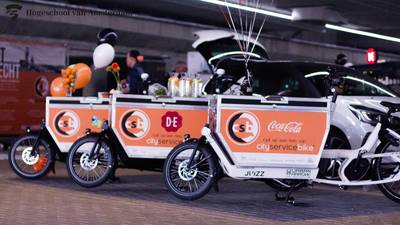LEVV staat voor Lichte, Elektrische VrachtVoertuigen in stedelijke distributie. Een consortium onder leiding van de HvA (Hogeschool van Amsterdam) wil dat de gemeenteraad kiest voor een autoluwe stad met uitstootvrij (vracht)verkeer. Daar kunnen deze transportmiddelen, denk aan vrachtfietsen met elektrische trapondersteuning, aan bijdragen.
DOCUMENT
De Hogeschool van Amsterdam (HvA) onderzoekt in het project LEVV-Logic de inzet van lichte elektrische vrachtvoertuigen (LEVV’s) voor de levering van goederen in steden. Natuurlijk is het handig dat je vrijwel alles, van nieuwe kleren tot je maaltijd aan toe, 24/7 thuis kunt laten bezorgen. Maar het creëert wel een logistieke uitdaging voor het milieu, het verkeer in de stad en de bezorgdiensten. Gelukkig lenen volgens internationaal onderzoek veel binnensteden zich goed voor LEVV’s en daar ligt een deel van de oplossing. De HvA onderzoekt hoe je in de binnenstad tegelijkertijd de luchtkwaliteit, bereikbaarheid en bezorgdiensten optimaliseert.
DOCUMENT
Waste collection is an important volume in city logistics today. In the LEVV-LOGIC project the Amsterdam University of Applied Sciences (NL) performed research on waste and the potential use of light commercial vehicles for waste collection in cities.
DOCUMENT
Susanne Balm, Maartje Stoop en Raymond Astudillio van Eijk waren de opdrachtgevers en hebben bijgedragen om de inhoud / boodschap vorm te geven.De maker is Turn2Improve.
YOUTUBE

For the company Deudekom, partner in the LEVV LOGIC project, the student have to calculate how many EV's can be charged at their location.
DOCUMENT

In het LEVV-LOGIC-project is onderzoek gedaan naar de inzet van LEVV’s in stadslogistiek. Het onderzoek is in 2016 gestart vanuit de behoefte van mkb-logistiek dienstverleners om LEVV’s rendabel in te zetten. Tijdens dit project hebben de Hogescholen van Amsterdam, Rotterdam en Arnhem en Nijmegen samengewerkt met logistiek dienstverleners, verladers, voertuigaanbieders, netwerkorganisaties, kennisinstellingen en gemeenten. Met elkaar hebben zij via workshops, praktijkonderzoek en experimenten nieuwe kennis ontwikkeld over logistieke concepten en businessmodellen voor de inzet van LEVV’s. Dit artikel is de conclusie van de eindpublicatie van LEVV-LOGIC. Deze is in hardcopy (mail naar levvlogic@hva.nl) en digitaal beschikbaar via www.hva.nl/levvlogic inclusief complete literatuurlijst.
LINK